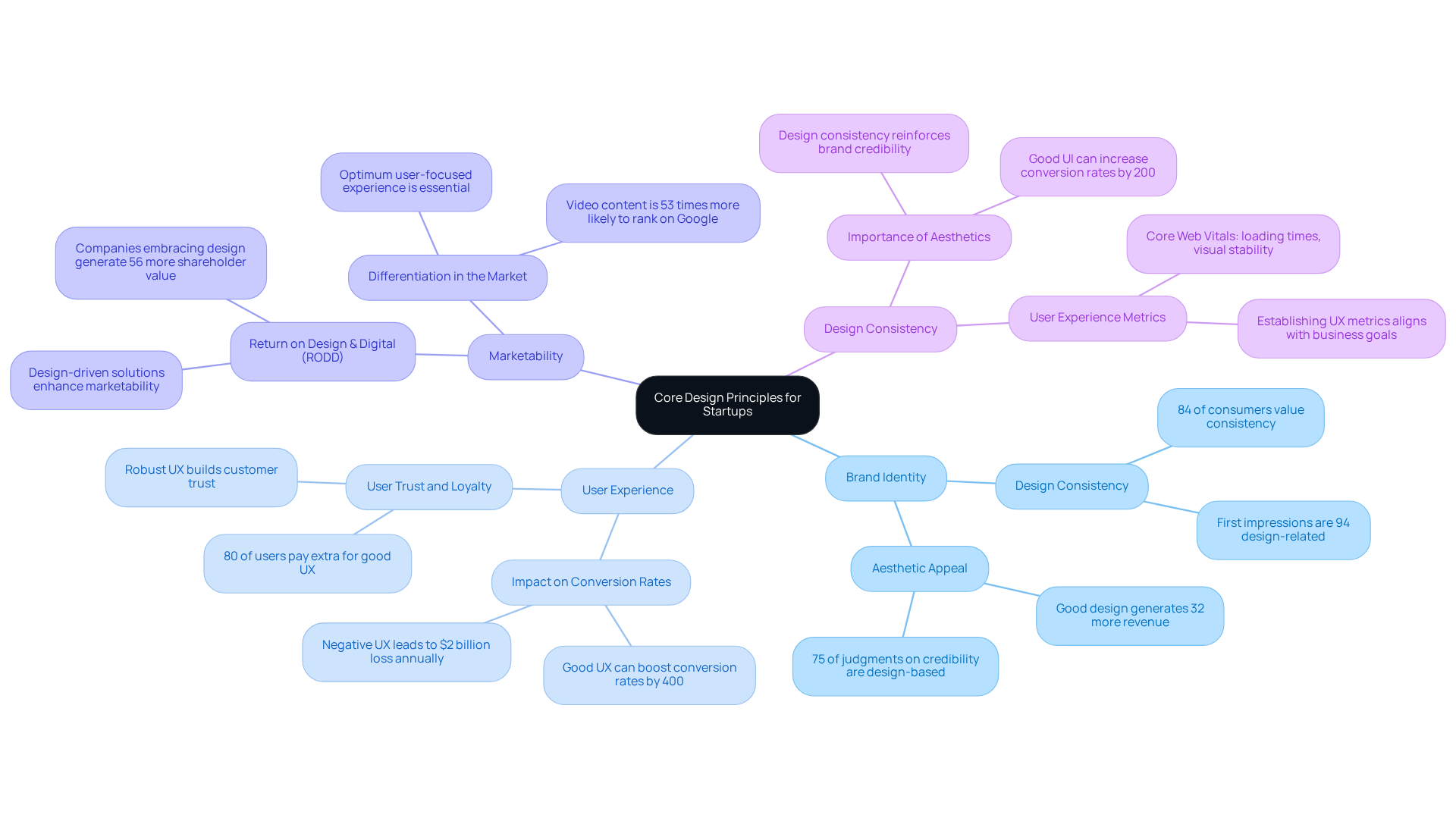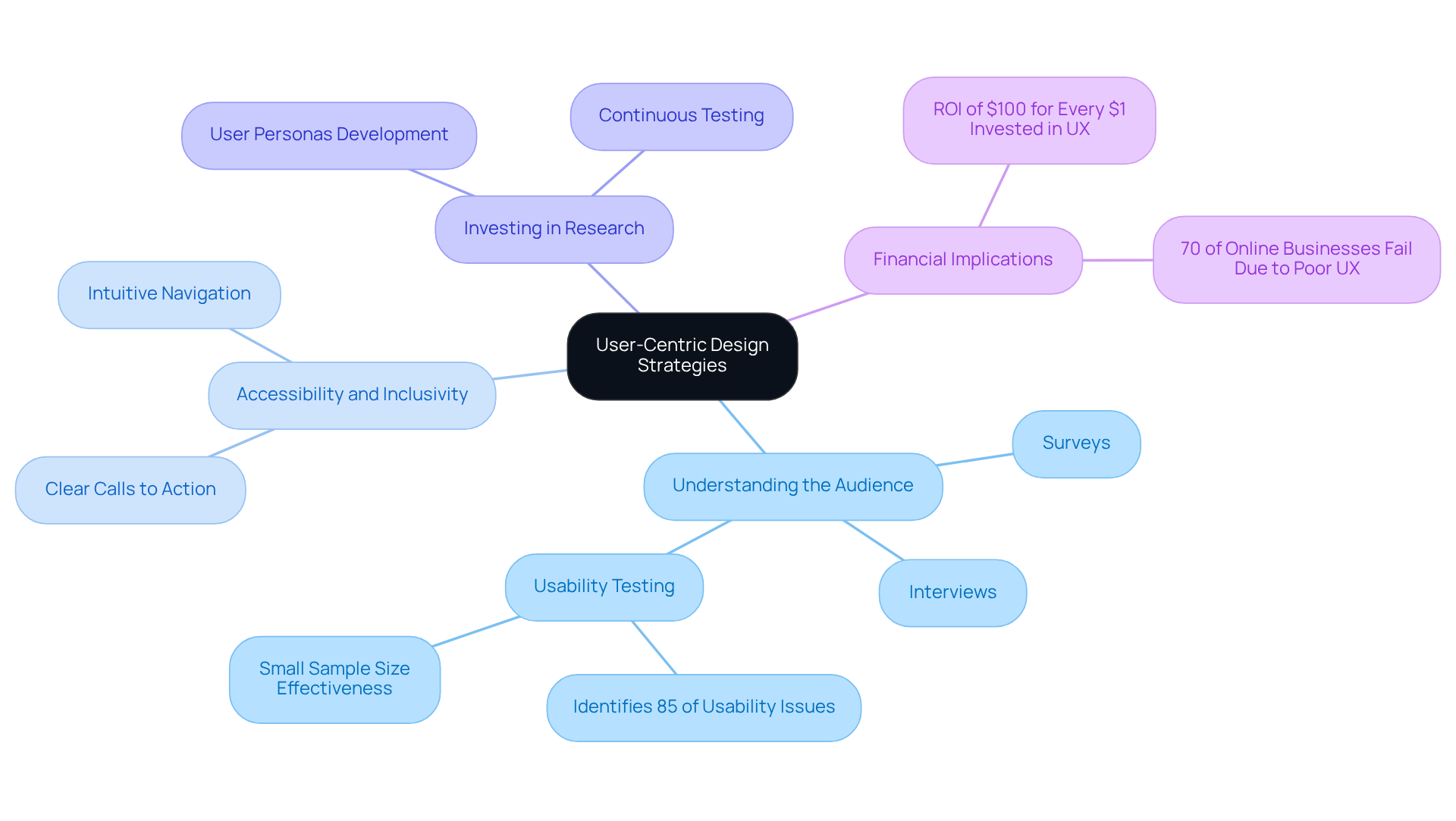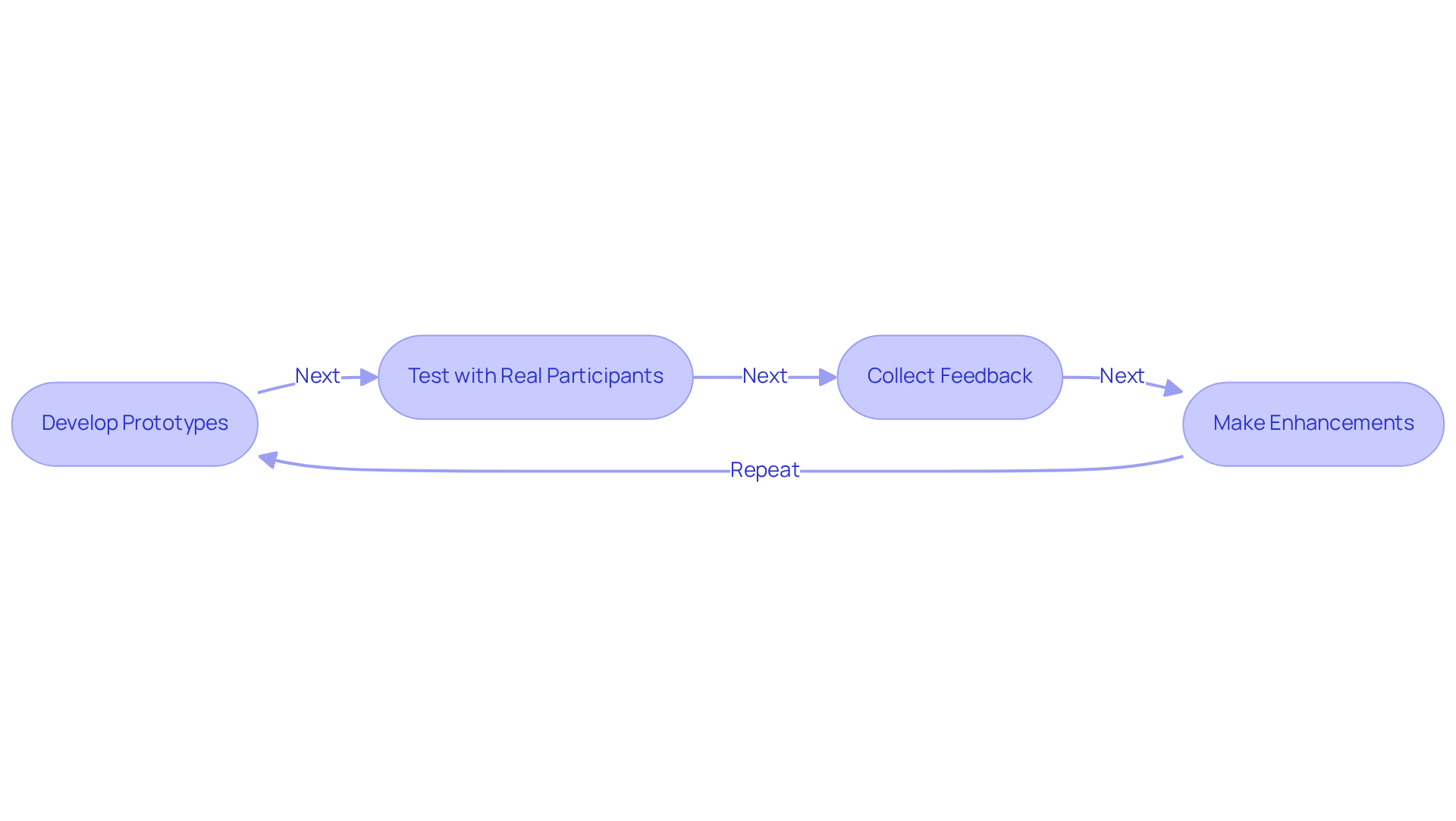Overview
In the fast-paced world of startups, many founders grapple with the challenge of establishing a strong design foundation. This struggle can lead to a fragmented brand identity and missed opportunities for creating meaningful user experiences. It’s essential to recognize that these issues not only hinder growth but can also stifle innovation and collaboration within your team.
However, there is hope. By embracing essential design practices, you can transform your startup’s approach to design. Establishing core design principles, implementing user-centric strategies, utilizing advanced design tools, and adopting iterative feedback processes can create a cohesive brand identity that resonates with your audience. These practices not only enhance user experiences but also foster a culture of innovation through collaboration.
As you embark on this journey, remember that your products must evolve alongside user needs. This evolution is crucial for achieving greater success and maintaining competitiveness in the market. By prioritizing these design practices, you’re not just addressing a problem; you’re nurturing a thriving community around your brand, ensuring that your startup not only survives but flourishes.
Introduction
Startups often find themselves at a crossroads, where the potential for innovation meets the challenge of establishing a strong brand identity. This is a common struggle, and it can feel overwhelming at times. In this dynamic landscape, mastering design is not merely an aesthetic choice; it is a strategic necessity that can significantly impact growth and customer engagement.
With the right practices in place, startups can harness the power of design to create products that resonate with their audience, foster loyalty, and ultimately drive revenue. However, what happens when the very principles that should guide this journey are overlooked? This oversight can lead to missed opportunities and a disconnect with potential customers, leaving founders feeling frustrated and uncertain.
Exploring essential design practices can illuminate the path to success, addressing the pitfalls that many startups face. Together, we can navigate these challenges and find the solutions that will help your startup thrive.
Establish Core Design Principles for Startups
Startups often face the challenge of defining their core principles, which are essential for shaping all visual and experiential elements. These principles should reflect the brand's mission, values, and target audience. For instance, a technology venture focused on innovation may highlight simplicity, functionality, and modern aesthetics. When startups establish these guidelines, they can ensure that every design aspect—from their logo to their website—demonstrates their and aligns with their overarching brand narrative. This consistency not only strengthens brand identity but also nurtures a cohesive user experience that resonates with customers.
At RNO1, we understand the importance of design mastery in developing design-driven solutions across every touchpoint, illustrating how startups can enhance their brand marketability through strategies like Return On Design & Digital (RODD). One practical approach is to create a manifesto that articulates these principles, serving as a guiding reference throughout the creation process. This is crucial, as studies show that 84% of consumers believe consistency across all touchpoints enhances a brand's credibility, ultimately fostering customer trust and loyalty. Furthermore, companies that embrace a strong aesthetic can generate 32% more revenue, and effective user experience (UX) can significantly improve website conversion rates, with exceptional UX boosting these rates by nearly 400%.
However, neglecting these principles can lead to missed opportunities. Many small business owners struggle to recognize the strategic significance of aesthetics amid their numerous responsibilities. By sharing these insights, we hope to encourage a deeper understanding of the value that well-defined core principles and design mastery can bring to your startup's journey.

Implement User-Centric Design Strategies
Startups often grapple with understanding their audience, which can feel overwhelming. It's crucial to prioritize thorough research to uncover insights into the needs, preferences, and challenges of their target demographic. Methods like surveys, interviews, and usability testing can reveal valuable information that directly influences development choices. For instance, a well-conducted usability test can uncover up to 85% of usability issues. Studies show that a small group of just five participants can discover this proportion of problems when testing consistently. Developing audience personas is another effective strategy, helping teams visualize their clientele and enabling customized solutions that truly connect with individuals.
Moreover, accessibility and inclusivity should be at the forefront of consideration processes. It's essential to ensure that products accommodate a diverse range of individuals. Take, for example, a startup creating a mobile application; focusing on intuitive navigation and clear calls to action is vital for enabling users to accomplish their goals. With 67% of visitors more inclined to purchase from a , understanding the needs of mobile layouts is crucial for enhancing user experiences.
Investing in audience research not only fosters innovation but also lays the groundwork for sustainable growth in a competitive environment. Every $1 invested in UX development can yield a return of $100, showcasing the financial advantages of prioritizing user-centric strategies. Additionally, with 70% of online enterprises collapsing due to poor UX, the stakes are high for startups to place the user at the core of their creation process. By embracing this approach, they can enhance product effectiveness and engagement, ultimately leading to higher conversion rates and greater customer satisfaction. Together, we can navigate these challenges and create solutions that resonate deeply with users.

Utilize Advanced Design Tools and Technologies
In today's fast-paced world, startups often struggle to cultivate an environment where creativity and collaboration can thrive. This challenge can lead to missed opportunities for innovation and connection with their audience. The emotional toll of feeling stuck can be overwhelming for founders who are passionate about their vision.
However, there is hope. By investing in advanced creative tools that promote collaboration, startups can align with [RNO1's commitment to solutions driven by creativity](https://rno1.com/revolve). Tools like Figma, Sketch, and Adobe XD facilitate real-time collaboration among team members, making it easier to share ideas and gather feedback.
Imagine your team, energized and connected, developing user-focused creations that resonate deeply with your audience. Furthermore, incorporating prototyping tools like InVision enhances RNO1's services in UX & UI creation and functional prototyping. These tools empower startups to visualize their concepts and test interactions before diving into full-scale development.
This iterative process not only enriches results but also fosters a nurturing culture of innovation and agility within teams. Ultimately, this approach drives rapid ROI and positions startups for a , allowing founders to feel supported and understood in their journey.

Adopt Iterative Design and Feedback Processes
Many startups face the daunting challenge of creating products that truly resonate with their users. This struggle can lead to frustration and uncertainty, especially when initial offerings do not meet expectations. However, there is a nurturing approach that can transform this experience: adopting a repetitive creation process enriched with frequent feedback cycles. By developing prototypes, testing them with real participants, and actively collecting feedback, startups can significantly improve their products and enhance the overall customer experience.
Agile methodologies shine in this context, allowing teams to work in sprints and make gradual enhancements based on valuable insights from clients. Consider the journey of Dropbox, which began as a minimum viable product. By attentively adjusting its offering according to initial participant feedback, Dropbox set the stage for its remarkable success. This illustrates how essential feedback loops can be; firms that embrace iterative development processes report a staggering 75% greater success rate in launches.
Moreover, engaging participants in the creation process has been shown to reduce development time by 30% while also boosting satisfaction ratings. This not only saves precious time but also fosters a deeper connection between the product and its users. By continuously iterating on their designs, startups can attain design mastery, ensuring their offerings evolve in harmony with user needs and market trends. This nurturing approach ultimately leads to greater success and fosters , especially in today's competitive landscape. Remember, you are not alone in this journey; by embracing these practices, you can cultivate products that truly resonate with your audience.

Conclusion
Building a solid foundation in design is a challenge many startups face, especially in today’s competitive markets. This struggle can lead to feelings of uncertainty and frustration, as the pressure to stand out and connect with audiences grows. However, by embracing core design principles, user-centric strategies, advanced tools, and iterative processes, startups can create products that not only resonate with their audience but also enhance their brand identity. This comprehensive approach nurtures creativity and innovation while cultivating customer loyalty and trust.
Throughout our journey together, we’ve explored essential practices that can transform your design process. Defining core principles that align with your brand's mission is crucial, as is prioritizing user research to truly understand audience needs. Leveraging advanced design tools for collaboration and adopting iterative feedback processes to refine your products are also vital steps. Each of these elements contributes significantly to achieving design mastery, empowering startups to navigate the complexities of their industries with confidence.
Remember, the path to design excellence is an ongoing journey that requires both commitment and adaptability. We encourage you to embrace these practices wholeheartedly. They not only enhance product effectiveness and user satisfaction but also lay the groundwork for sustainable growth and success. By prioritizing design mastery today, you position your startup for a brighter, more innovative future in an ever-evolving landscape. Together, let’s create a community where your design aspirations can flourish.
Frequently Asked Questions
Why are core design principles important for startups?
Core design principles are essential for shaping all visual and experiential elements of a startup. They reflect the brand's mission, values, and target audience, ensuring consistency across all design aspects, which strengthens brand identity and enhances user experience.
How can startups establish their core design principles?
Startups can establish their core design principles by creating a manifesto that articulates these principles, serving as a guiding reference throughout the creation process.
What impact does design consistency have on consumer perception?
Studies show that 84% of consumers believe consistency across all touchpoints enhances a brand's credibility, which fosters customer trust and loyalty.
How does a strong aesthetic influence a company's revenue?
Companies that embrace a strong aesthetic can generate 32% more revenue compared to those that do not.
What is the relationship between user experience (UX) and website conversion rates?
Effective user experience (UX) can significantly improve website conversion rates, with exceptional UX boosting these rates by nearly 400%.
What challenges do small business owners face regarding design principles?
Many small business owners struggle to recognize the strategic significance of aesthetics amid their numerous responsibilities, which can lead to missed opportunities.
What is Return On Design & Digital (RODD)?
Return On Design & Digital (RODD) is a strategy that illustrates how startups can enhance their brand marketability through design-driven solutions across various touchpoints.




